Cisco Linksys WPC11-V31 Wireless Network PC Radio Card User Manual wpc11 ver3 0 user guide
Cisco-Linksys, LLC Wireless Network PC Radio Card wpc11 ver3 0 user guide
Contents
- 1. DoC Statement
- 2. Users Manual 1
- 3. Users Manual 2
Users Manual 2

32
Chapter 7: Configuration Utility
The Configuration Utility is provided to allow you further customization of
the Network PC Card and your wireless network.
Once the Configuration Utility has been installed, an icon will be placed in the
system tray (next to the clock) when the Network PC Card is inserted, as shown
in Figure 7-1.
You can also start the Configuration Utility by clicking the Start button, select-
ing Programs, and choosing the folder for the Network PC Card. Choose
Configuration Utility. You will see the Wireless LAN Configuration Utility
screen (shown in Figure 7-1). This utility is divided into six parts: Link Info,
Configuration, Site Survey, Encryption, Advanced, and About. You should
change all configuration settings for your Network PC Card using this utility
and not under the Network Properties section in your Control Panel.
LINK INFO
The Link Info screen (shown in Figure 7-2) provides information about the cur-
rent link between the Network PC Card and a wireless Access Point.
When in Infrastructure Mode, State will display the connection statistics for
the network segment that you are on.
The Current Channel field shows to what channel the Network PC Card is set.
The Current Transfer Rate field shows the transfer rate in megabits per sec-
ond.
The Current Service Set Identifier shows the current SSID set for the wire-
less network. This SSID can be modified at the Configuration screen.
The Throughput fields show the rate at which data is transferred and received
in Bytes per second.
Using the Configuration Utility
Figure 7-1
If this screen does not appear automatically, you can access the installation by
clicking the Start button and choosing Run. In the drop-down box provided,
type D:\setup.exe (where D: is the letter of your CD-ROM drive). Alternately,
double-click My Computer, and then double-click the CD-ROM drive where
the Setup Utility CD is located. Double-click the Setup.exe icon that appears.
Follow the instructions that appear on your screen. If you have any questions
or difficulty, refer to the section called Installing the Drivers and
Configuration Utility for Windows 95, 98, ME, and 2000.
Network PC Card
Instant Wireless
TM
Series
31
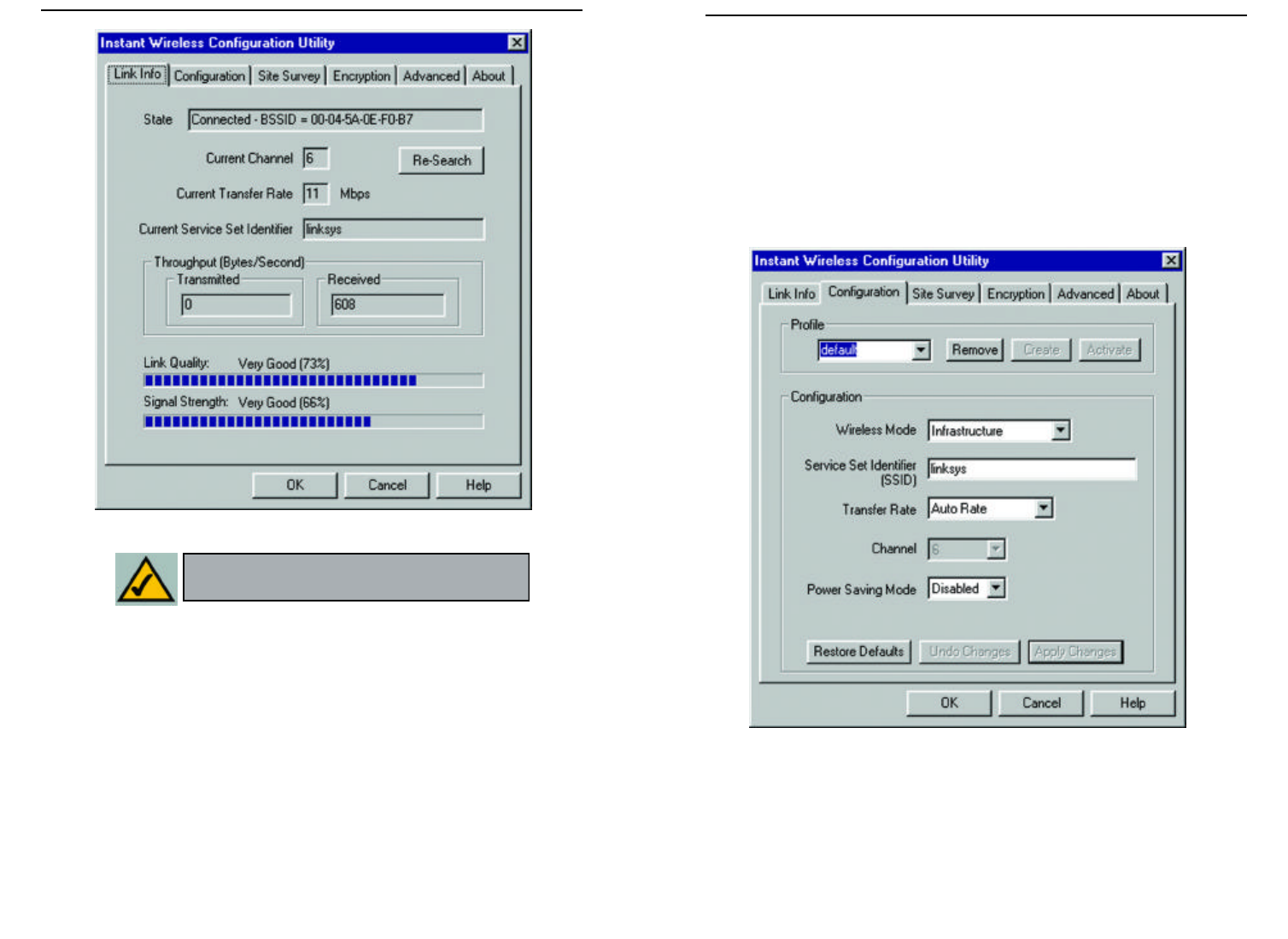
34
CONFIGURATION
The Configuration screen, shown in Figure 7-3, allows you to customize the
settings for the Network PC Card and your wireless network.
The Wireless Mode setting determines the architecture of your wireless net-
work. Select Ad-Hoc or Infrastructure Mode depending on your network
type. The Ad-Hoc mode is used for a simple peer-to-peer network and allows
the sharing of local resources only between Network PC Cards without need-
ing a wireless Access Point. The Infrastructure mode allows a wireless net-
work to be integrated into an existed, wired network through an Access Point.
Infrastructure networks permit roaming between Access Points while main-
taining a connection to all network resources.
An acronym for Service Set Identifier, SSID is the unique name shared among
all points in a wireless network. The SSID must be identical for all points in the
network. It is case sensitive and must not exceed 32 characters.
Figure 7-3
The Link Quality field will display a bar indicating the percentage, between 0
and 100 percent, of the quality of the link. The higher the percentage, the bet-
ter the link.
The Signal Strength field will display a bar indicating the percentage, between
0 and 100 percent, of the strength of the signal. The higher the percentage, the
stronger the signal.
Note: When in Ad-Hoc mode, Link Quality and
Signal Strength indicators will not be available.
Figure 7-2
Network PC Card
Instant Wireless
Series
33
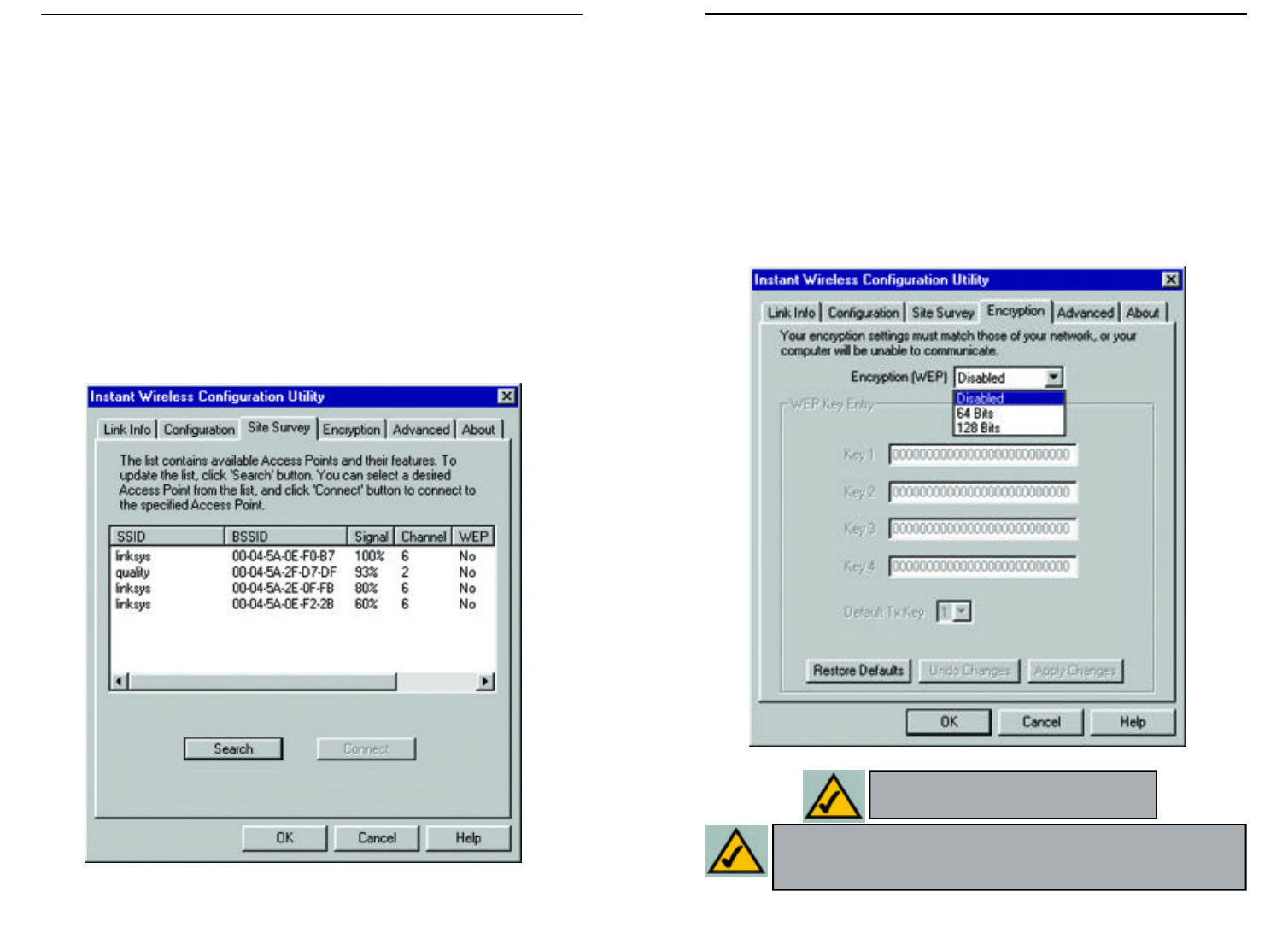
35
ENCRYPTION
On the Encryption screen, shown in Figure 7-5, you can set the level of security
with which you will be using the Network PC Card.
Under the drop-down box, you can choose to have WEP encryption Disabled, 64-
Bit, or 128-Bit. Wired Equivalent Privacy (WEP) is an encryption scheme used to
protect wireless data communication. The Disabled setting prevents the sharing of
data with other computers on the WEP network. When selecting Manual Entry
for the WEP Key Entry, enter the hexadecimal number set by other wireless WEP
settings; these settings have to be identical to the WEP encryption on all points in
your wireless network in order to network to your Network PC Card.
Note: In order to enable WEP encryption,
hexadecimal values must be entered.
Figure 7-5
Note: The WEP Key Entry must match the Key on all other devices
on the wireless network, or else this device will be unable to trans-
mit or receive data.
The Transfer Rate field shows the current transfer rate for the Network PC
Card. To optimize performance and range, the TX Rate should be set to Fully
Automatic, which will automatically adjust the transfer speed for best per-
formance and longest range.
The Channel setting specifies the channel used in wireless communication and
should be set to the same channel as the other points in the wireless network.
This setting can only be adjusted in Ad-Hoc mode.
Power Saving Mode, or PS Mode, enables or disables the power saving features
of your Network PC Card.
SITE SURVEY
The Site Survey screen shows the available access points and their features.
Click on the desired access point. Then click Connect to connect or Search to
search for more access points.
Network PC Card
Figure 7-4
Instant Wireless
TM
Series
36
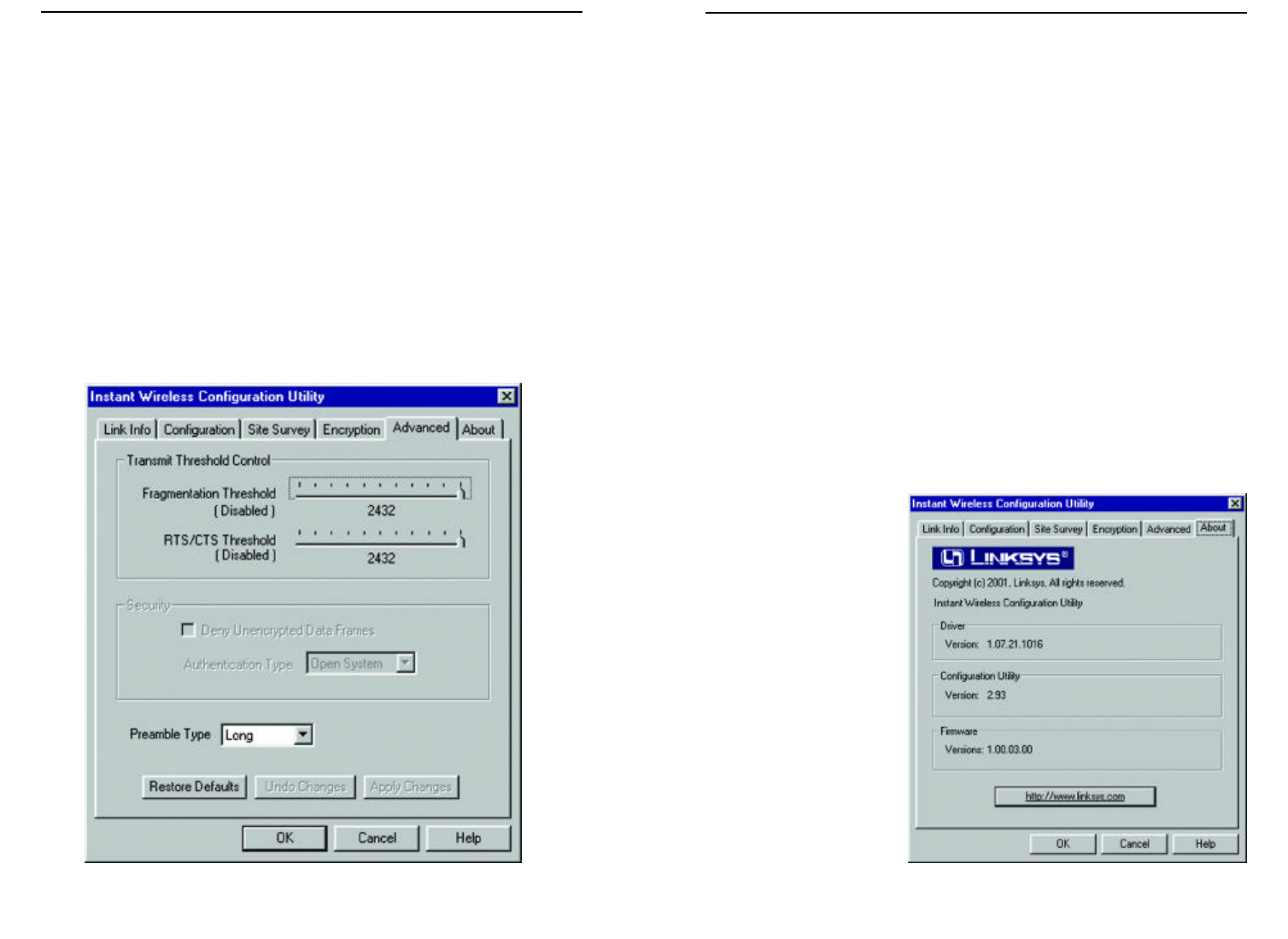
37
The RTS Threshold Value should remain at its default setting of 2,432. A pre-
amble is a signal used to synchronize the transmission timing between two or
more systems. A series of transmission pulses is sent before the data to indicate
that “someone is about transmit data.” This ensures that systems receiving the
information correctly when the data transmission starts.
Security is used for WEP only. By selecting Deny Unencrypted Data
Frames, all unencrypted data will not be seen. For Authentication Type, you
may choose between Open System or Shared Key.
Shared Key is when both the sender and recipient share a secret key. Both
units use this key for an extended length of time, sometimes indefinitely.
Any eavesdropper that discovers the key may decipher all packets until the
key is changed.
Open System, the default setting, is when the sender and the recipient do
not share a secret key. Each party generates its own key-pair and asks the
receiver to accept the (usually randomly) generated key. Once accepted,
this key is used for a short time only; then a new key is generated and
agreed upon.
The Preamble Type
should be set to Short (if
the network environment
is “noisy”) or Long (if the
environment is clear).
Click OK to complete the
configuration.
ABOUT
The About screen (Figure
7-7) shows the release
information for the Driver
Version, Configuration
Utility Version, and
Firmware Version
Figure 7-7
In order to enable 128-bit WEP encryption, choose 128 Bits in the drop-down
box. In the drop-down box near the bottom right-hand corner of the page,
choose which Default Tx Key will be used for the encryption. By default, Key
1 will be used. In the box corresponding to the default you chose, enter a hexa-
decimal number that the encryption algorithm will be based on. Click Apply
Changes when you are done.
ADVANCED
The Advanced screen (Figure 7-6) allows you to set the Fragmentation
Threshold, the RTS/CTS Threshold, and the Preamble Type. The
Fragmentation Threshold Value indicates how much of the network resources
is devoted to recovering packet errors. The value should remain at its default
setting of 2,432. If you experience high packet error rates, you can decrease this
value but it will likely decrease overall network performance. Only minor mod-
ifications of this value are recommended.
Network PC Card
Figure 7-6
Instant Wireless
Series
38
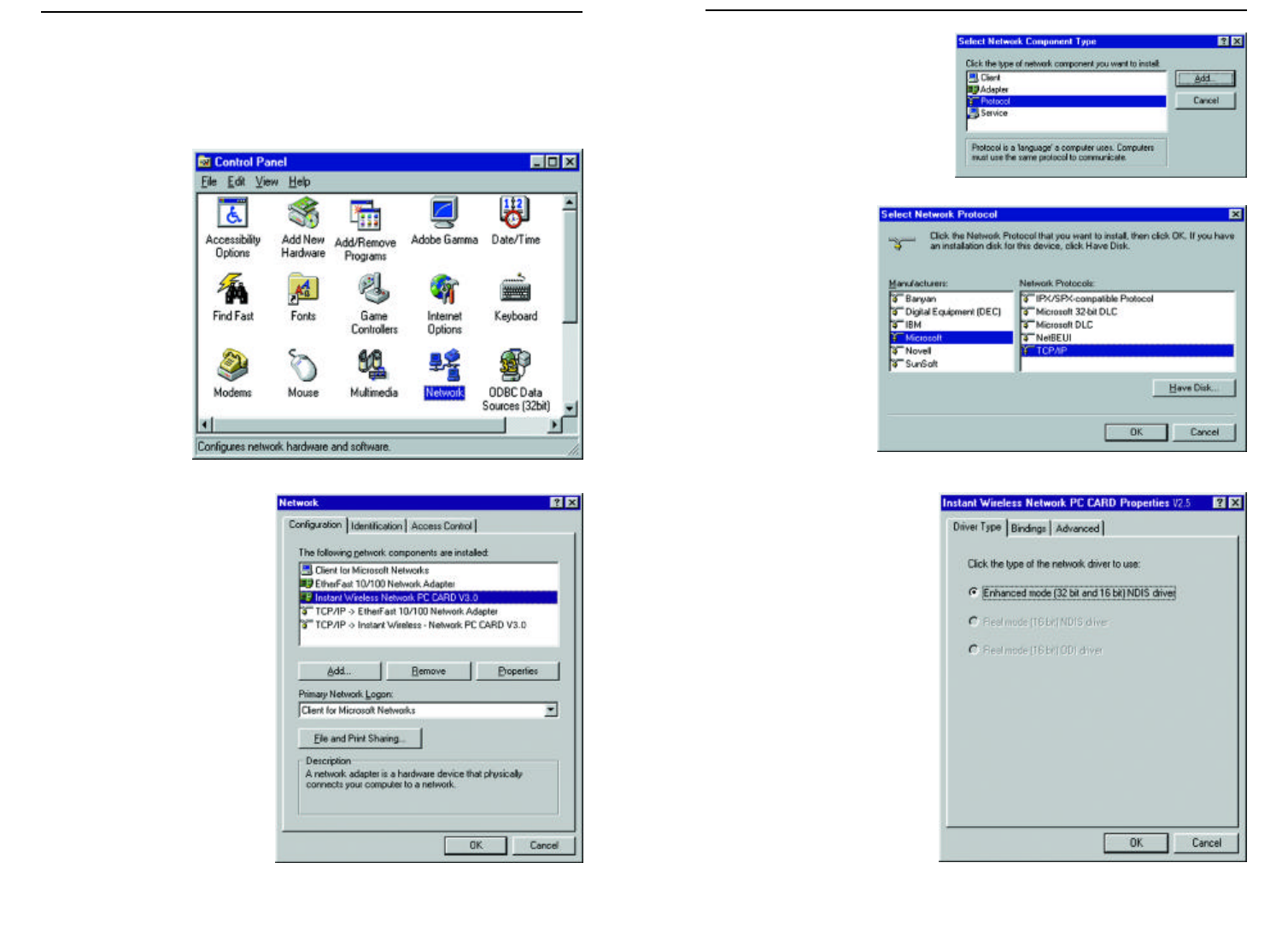
3. Highlight Protocol from the
list of network component
types, as shown in Figure 8-3,
and click the Add button.
4. From the screen
shown in Figure 8-
4, select Microsoft
from the list of
“Manufacturers”
and TCP/IP from
the list of “Network
Protocols” and click
the OK button.
Repeat steps two
through four to
install other proto-
cols, such as
NetBEUI or IPX/SPX.
5. To verify that the drivers are
working under Enhanced
Mode on the Driver Type tab
or reconfigure the card on
the Advanced tab, go to the
screen shown in Figure 8-2
and click the Properties but-
ton. This will bring up the
Properties Tabs, where such
values can be refined.
When finished, you must
restart your computer to
complete installation.
40
Chapter 8: Installing Network
Protocols
Protocols are necessary for computers to communicate on your network.
1. From the Start
Menu, select
Settings and
bring up the
Control Panel,
as shown in
Figure 8-1. From
the Control
Panel, double-
click the
Network icon.
2. Select Instant Wireless
Network PC Card V3.0
from the list (as shown in
Figure 8-2) and click the
Add button.
39
Figure 8-3
Figure 8-4
Figure 8-5
Network PC Card
Figure 8-1
Figure 8-2
Instant Wireless
Series
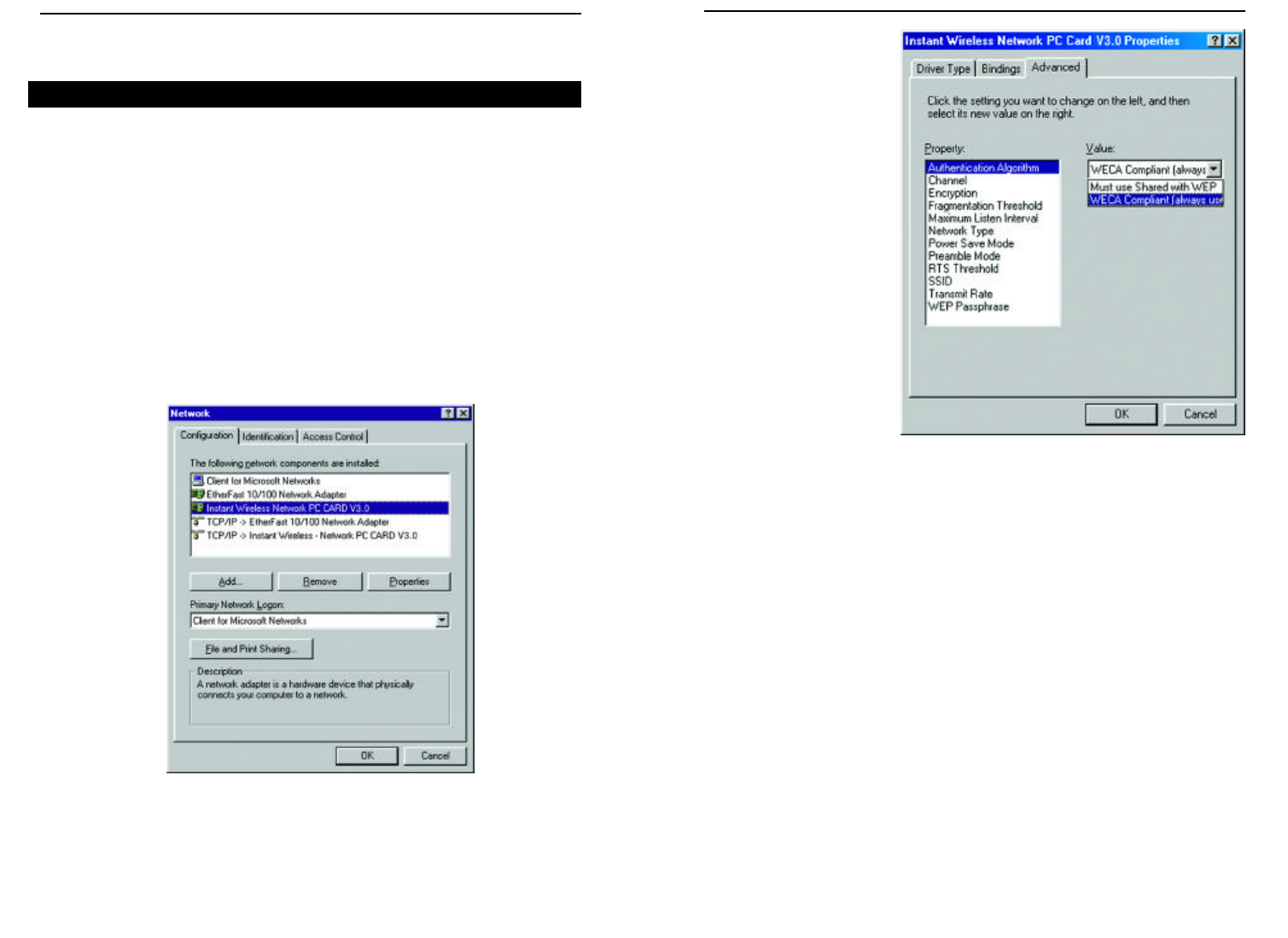
2. Select Authentication
Algorithm from the list
provided and select a
Value from the drop-
down menu on the
right, as shown in
Figure 9-2.
WECA Compliant (Default) (also referred to as Open Authentication)
The sender and recipient do NOT share a secret key. Each party generates its
own key-pair and asks the receiver to accept the generated key. Once accept-
ed, this key is used for a short time only.
Must use Shared with WEP (Optional)
This is when both the sender and recipient share a secret key. They use this key
for an extended length of time. Any eavesdropper that discovers the key may
decipher all packets until the key is changed. As indicated, you should always
use WECA Compliant (Always Use) unless you have some other reason to do
so.
Choose Channel to continue or click the OK button to finish setting the
Advanced Options
Figure 9-2
Network PC Card
Chapter 9: Advanced Properties
The Advanced Properties of the card are supplied for fine tuning the card’s set-
tings. These values should only be changed by those completely familiar with
both the operating system and the settings of the network. Unless your specif-
ic situation requires changing them, the default settings should be sufficient for
your card’s proper operation. Linksys advises that you change these values in
the Configuration Utility rather than using this method, to insure that the set-
tings you change will be recognized everywhere.
Check your wireless network settings before changing any of these values.
1. To access the Network Configuration screen (shown in Figure 9-1), click the
Start button, choose Settings and open the Control Panel. Double-click the
Network icon and choose the Advanced tab.
The Advanced Properties for Windows 95, 98, ME, and 2000
Figure 9-1
Instant Wireless
TM
Series
41 42
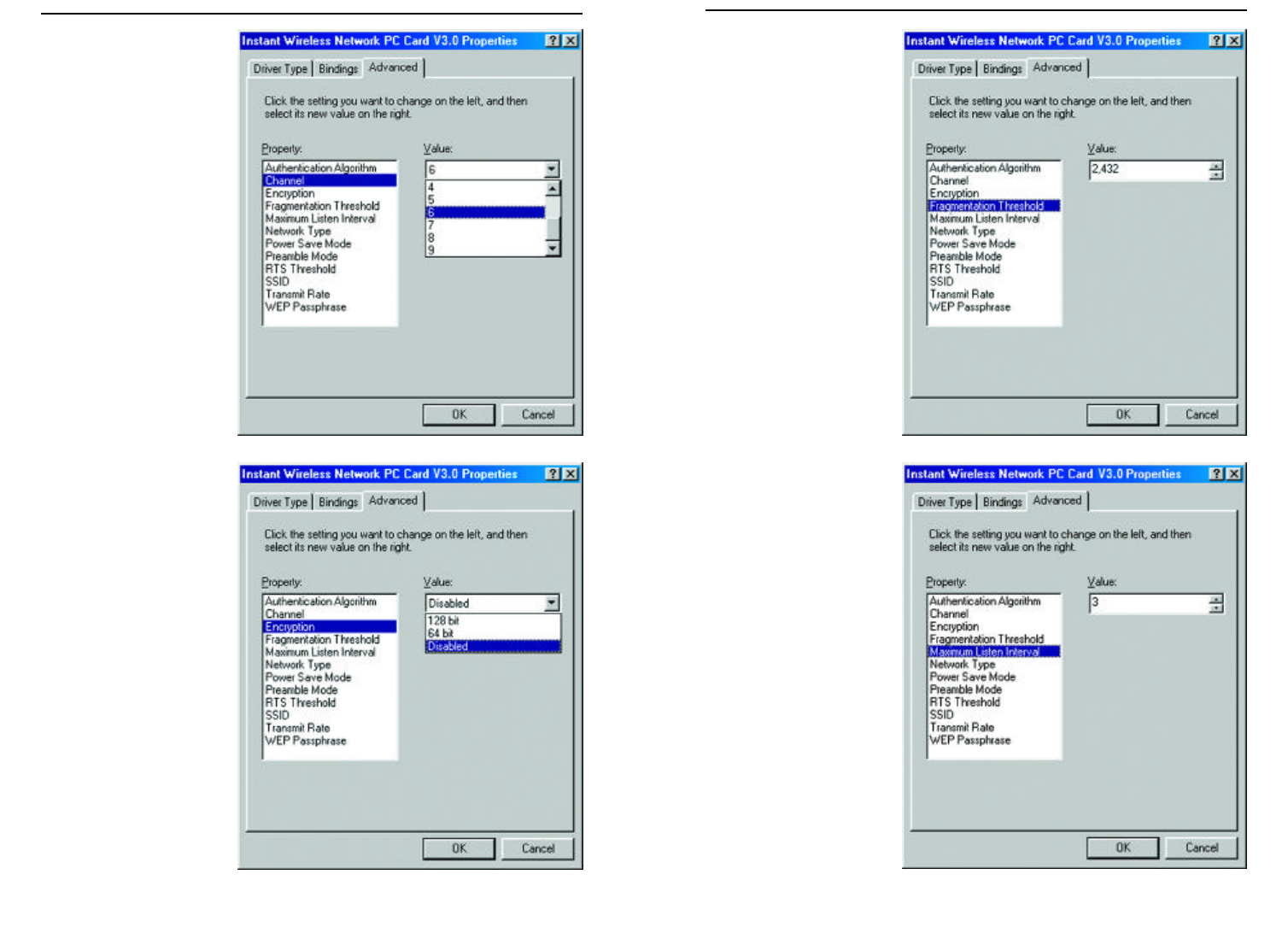
5. The Fragmentation
Threshold Value,
shown in Figure 9-5 indi-
cates the maximum size
of the transmit frame.
Any data frame larger
than this value will be
fragmented into multiple
frames. Lowering this
value usually means a
lower frame error rate,
but a lower value also
creates more overhead,
which negatively affects
network performance.
The value can only be
entered in increments of
128. Only minor modi-
fications of this value are
recommended. Click
Maximum Listen
Interval to continue or
the OK button to finish
setting the Advanced
Options.
6. The Maximum Listen
Interval, as shown in
Figure 9-6, only applies
when operating in the
Infrastructure mode
while Power Saving is
enabled. The value you
input here will deter-
mine how often the com-
puter “wakes up” from
the power saving mode
to receive any packets
that were sent while it
was “asleep.” The higher
the value entered here,
the longer the time your
computer “sleeps”
between waking up to
check for packets. Click
Network Type to con-
tinue or the OK button
to finish setting the
Advanced Options.
3. The Channel setting,
shown in Figure 9-3,
must be the same for
all wireless points in
the network. Use the
settings, 1-11, to find
the best channel for
your connection. For
further information,
see Chapter 7:
Configuration
Utility. Once your
card is configured,
click the OK button to
finish setting the
Advanced Options.
4. Select either Disabled, 64
bit, or 128 bit as the
value under Encryption,
shown in Figure 9-4.
Wired Equivalent
Privacy (WEP) is an
encryption method used
to protect wireless data
communication. The
Disabled setting pre-
vents the sharing of data
with other computers on
a WEP network. For data
sharing to be enabled,
select either 64 or 128 bit
encryption, depending
on your needs. For fur-
ther information, see
Chapter 7:
Configuration Utility.
Once your card is con-
figured, click OK to fin-
ish setting the Advanced
Options.
Network PC Card
Figure 9-5
Figure 9-6
Figure 9-3
Figure 9-4
Instant Wireless
TM
Series
43 44
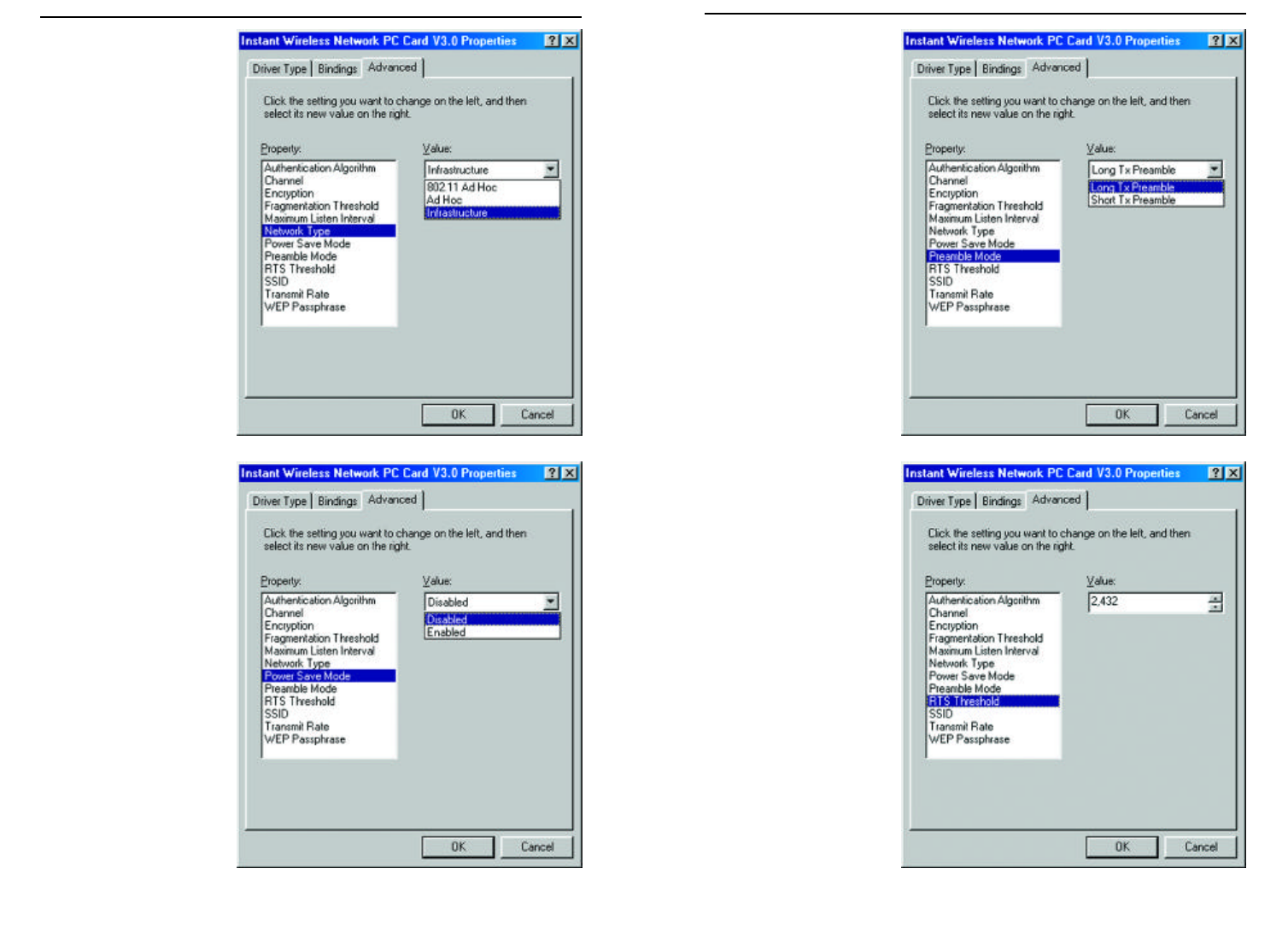
9. A preamble is a signal
used to synchronize
the transmission tim-
ing between two or
more points in your
wireless network.
The default setting is
Long Tx Preamble
(as shown in Figure 9-
9). Long Tx Preamble
allows extra time for
the digital decoder to
process the initial
header packets, but is
transmitted at
11Mbps. Short Tx
Preamble allows for
less time to process
the packets, but initial
packets are transmit-
ted at 2Mbps. Click
SSID to continue or
the OK button to fin-
ish setting the
Advanced Options.
10. RTS Threshold
should remain
Disabled the default
setting, as shown in
Figure 9-10. Do not
change the setting of
the RTS Threshold
unless connection
quality is poor. Then,
increase this setting by
a small value to estab-
lish a better connec-
tion. Click Network
Type to continue or
the OK button to fin-
ish setting the
Advanced Options.
Network PC Card
7. Select Network Type
(Figure 9-7) and select a
Value, from the drop
down menu, of either
Infrastructure or Ad-
Hoc.
The Infrastructure mode
allows a Network PC
Card to communicate
with a wired network
employing an access
point, while the Ad-Hoc
mode allows wireless-
to-wireless, peer-to-peer
communication. Click
Power Save Mode to
continue or the OK but-
ton to finish setting the
Advanced Options.
8. Select Power Save
Mode (shown in Figure
9-8) and select either
Enabled or Disabled
for the Value. Disabled
will allow for uninter-
rupted data communica-
tion. Selecting Enabled
allows your notebook to
enter “sleep” mode and
could interrupt data
communication. For
further information
about Power Save
Mode, see Chapter 7:
Configuration Utility.
Click Preamble Mode
to continue or the OK
button to finish setting
the Advanced Options.
Figure 9-9
Figure 9-10
Figure 9-7
Figure 9-8
Instant Wireless
TM
Series
45 46
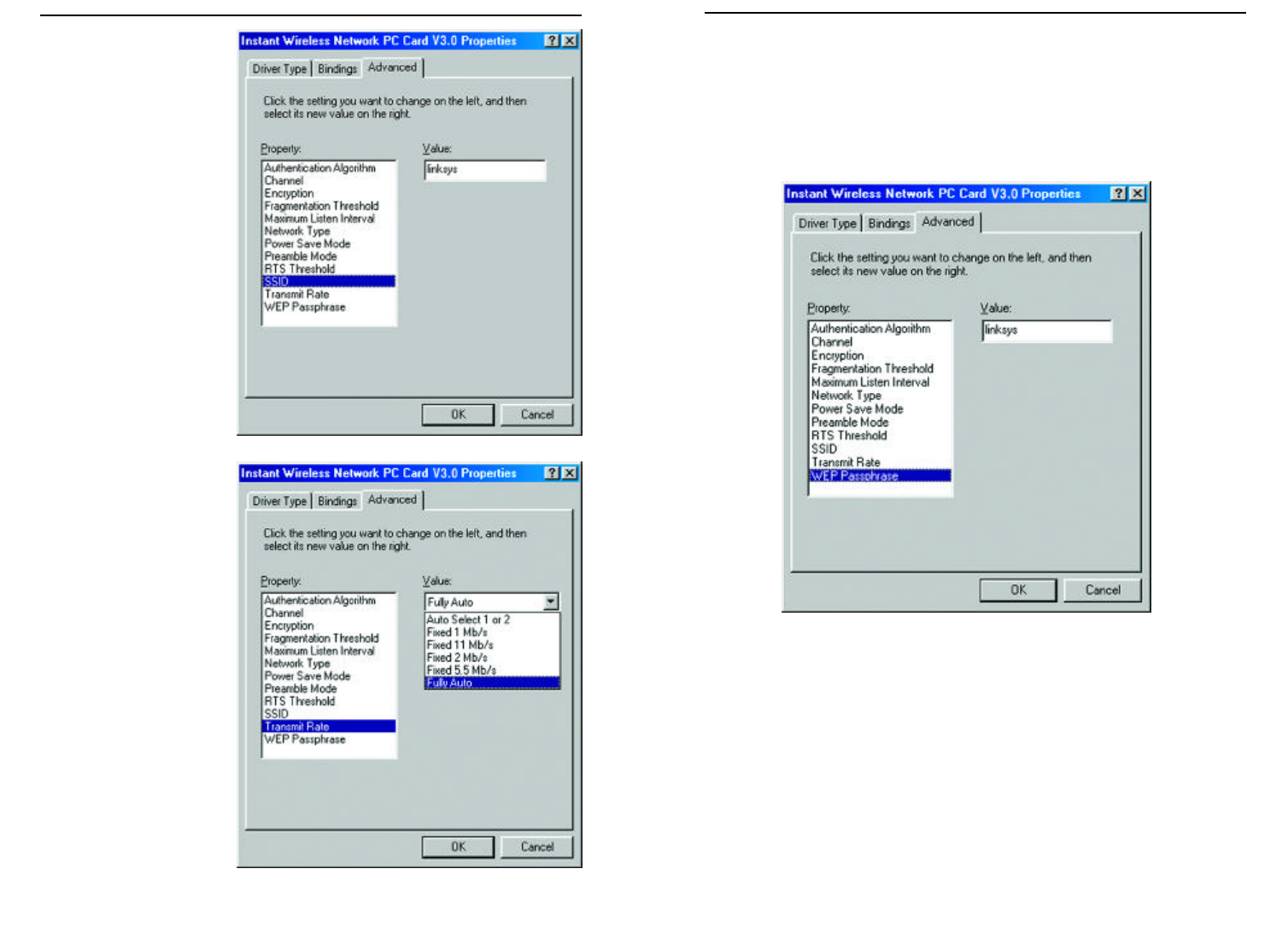
13. The WEP Passphrase (Figure 9-13) value allows the user to change the
passphrase that is used to generate the encryption key for WEP. Any
alphanumeric value can be entered here, but it will only be activated if you
choose either 64 or 128 bit under Encryption. This value can also be
changed using the Configuration Utility. For further information, see
Chapter 7: Configuration Utility.
Once your card is configured, click the OK button to finish setting the
Advanced Options.
Network PC Card
11. The value for SSID
(Figure 9-11) depends
on what Network
Type was selected.
Infrastructure net-
works should have the
same SSID as the
Access Point. All
clients in an Ad-Hoc
Network should share
the same SSID. Click
Transmit Rate to
continue or the OK
button to finish set-
ting the Advanced
Options.
12. The Transmit Rate
affects the speed of
transmission to anoth-
er wireless device.
The rate can either be
set to a fixed value or
left at the default value
of Full Auto, as shown
in Figure 9-12, which
lets the computer
determine the best
transfer rate. The first
option, Auto Select 1
or 2, is for compatibil-
ity with older wireless
equipment. Click
WEP Passphrase to
continue or the OK
button to finish setting
the Advanced Options.
Figure 9-13
Figure 9-11
Figure 9-12
Instant Wireless
TM
Series
47 48
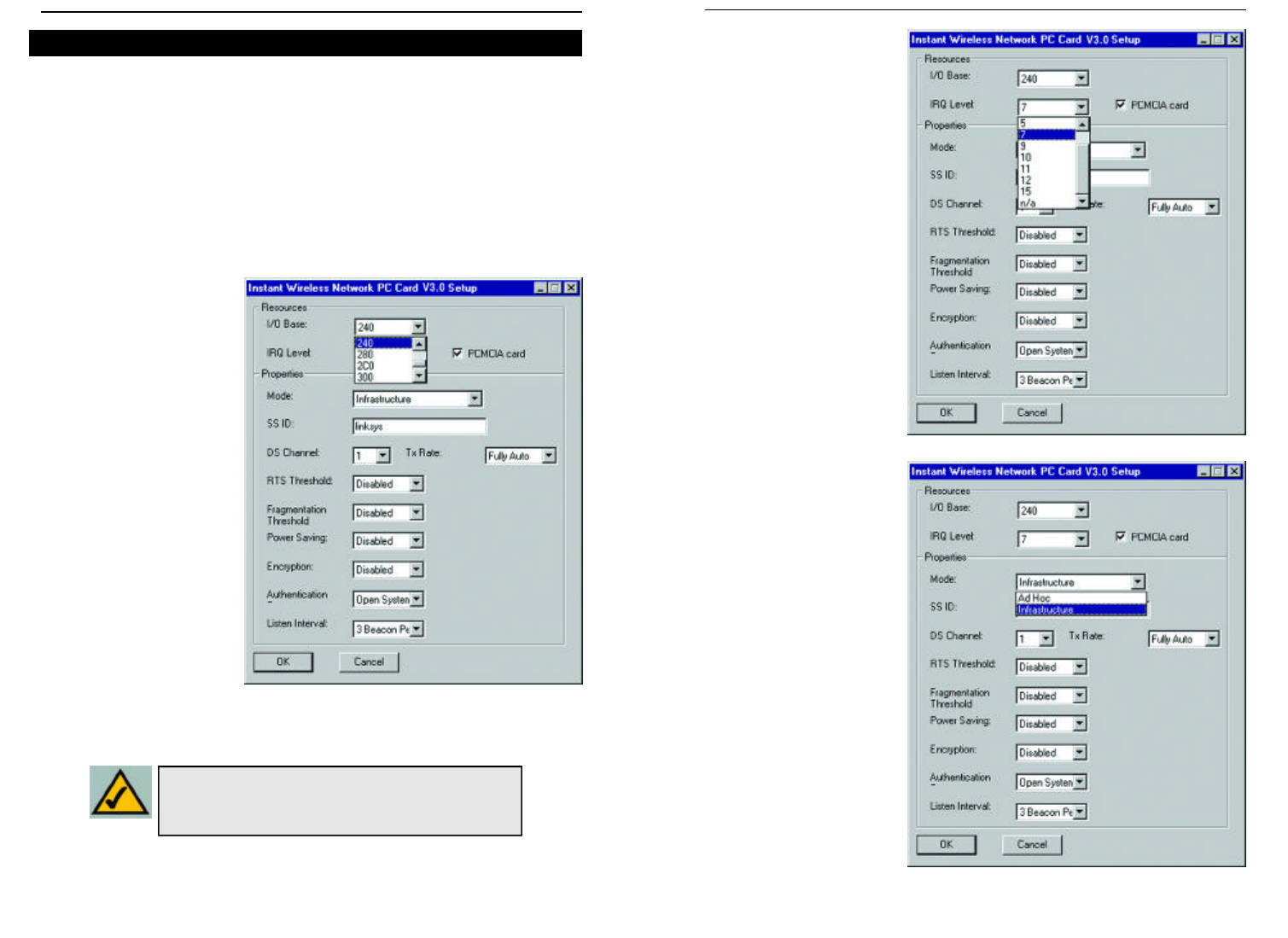
2. The IRQ Base level
(Figure 9-15) can be
changed in order to
avoid possible conflicts
with other system
devices. The default
setting for the Network
PC Card is 7. This
value should only be
changed if the Card
does not work properly.
3. The Mode setting (Figure
9-16) should be either
Infrastructure or Ad-
Hoc, depending upon
your network’s settings.
The Infrastructure
mode allows
a Network PC Card to
communicate with a
wired network employing
an access point, while the
Ad-Hoc mode allows
wireless-
to-wireless, peer-to-peer
communication. For
more information about
these settings, refer to the
section in Chapter 3
called Ad-Hoc versus
Infrastructure Mode.
The Advanced Properties screen allows you to make modifications to your
Network PC Card, optimizing performance. These properties are accessed by
right-clicking on the Network Neighborhood icon on the desktop. Select
Properties from the menu that appears. From the tabbed window that appears
next, click the Adapters tab. Highlight Instant Wireless Network PC Card
V3.0 and then click the Properties button. The screen in Figure 9-14 should
appear. Choosing improper settings in these fields can keep the Wireless
Network PC Card from functioning properly. Follow these steps to configure
the Advanced Properties fields:
1. The I/O Base setting,
shown in Figure 9-14,
should be unique and
not conflict with any
other device settings in
your system.
The Advanced Properties for Windows NT
Note: In order to check for potential IRQ conflicts,
run WINMSD by selecting RUN from the Start menu
and typing winmsd.exe and pressing the Enter key.
Network PC Card
Figure 9-14
Figure 9-15
Figure 9-16
Instant Wireless
Series
49 50
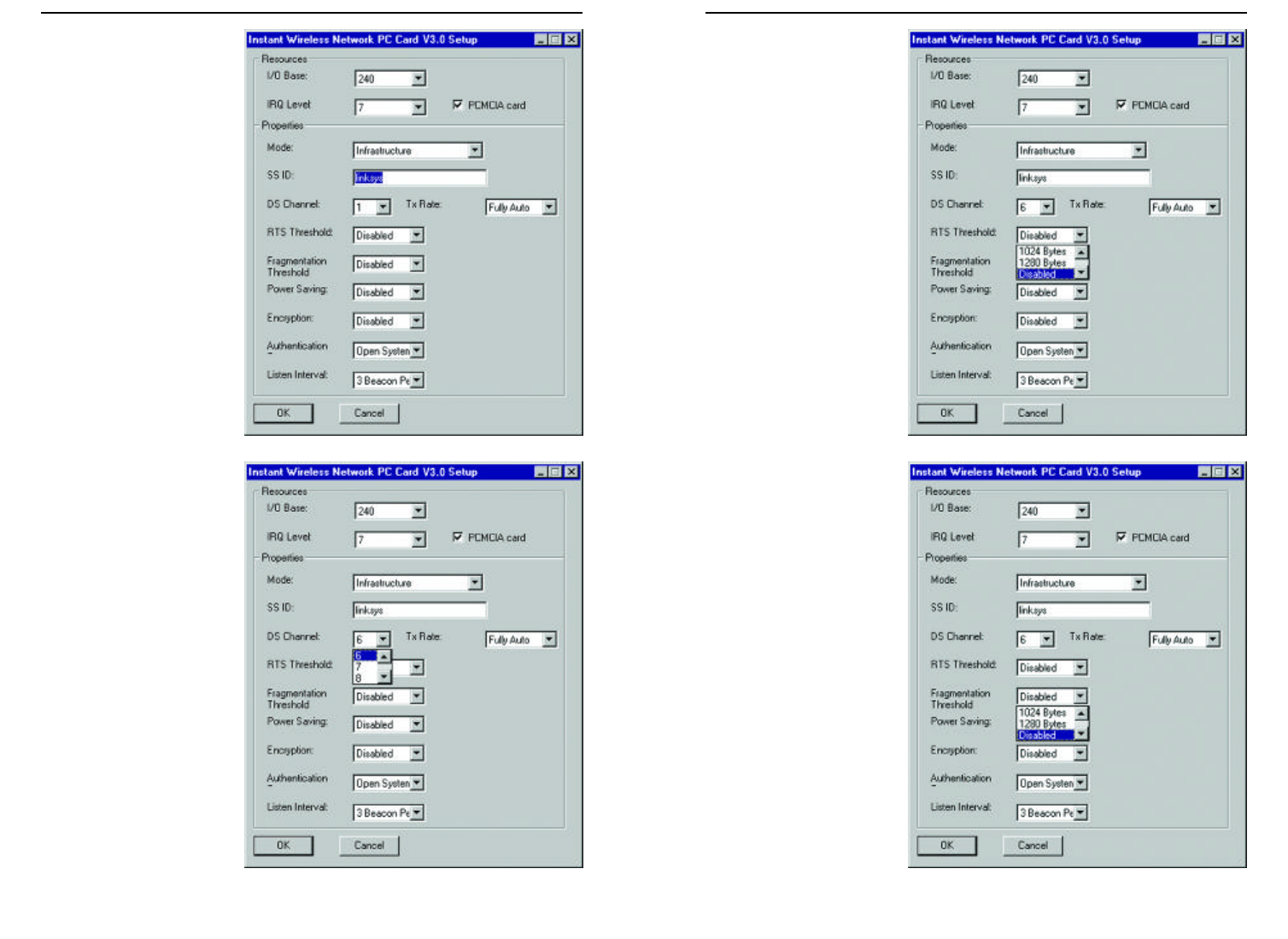
6. RTS Threshold should
remain in the default
setting of Disabled, as
shown in Figure 9-19.
Do not change the set-
ting of the RTS
Threshold unless con-
nection quality is poor.
Then, increase this set-
ting by a small value to
establish a better con-
nection.
7. Fragmentation
Threshold should
remain in the default
setting of Disabled,
as shown in Figure 9-
20. Do not change the
setting of the
Fragmentation
Threshold unless con-
nection quality is
poor. Then, increase
this setting by a small
value to establish a
better connection.
4. The SSID (as shown in
Figure 9-17) depends
on what Mode is
selected. If the Mode
is Infrastructure, it
should have the same
SSID name as the
Access Point. If the
Mode is Ad-Hoc, all
clients should share
the same SSID name.
5. The DS Channel set-
ting (Figure 9-18) must
be the same for all
wireless points in the
network. Use the set-
tings, 1-11, to find the
best channel for your
connection.
Network PC Card
Figure 9-17
Figure 9-18
Figure 9-19
Figure 9-20
Instant Wireless
TM
Series
51 52
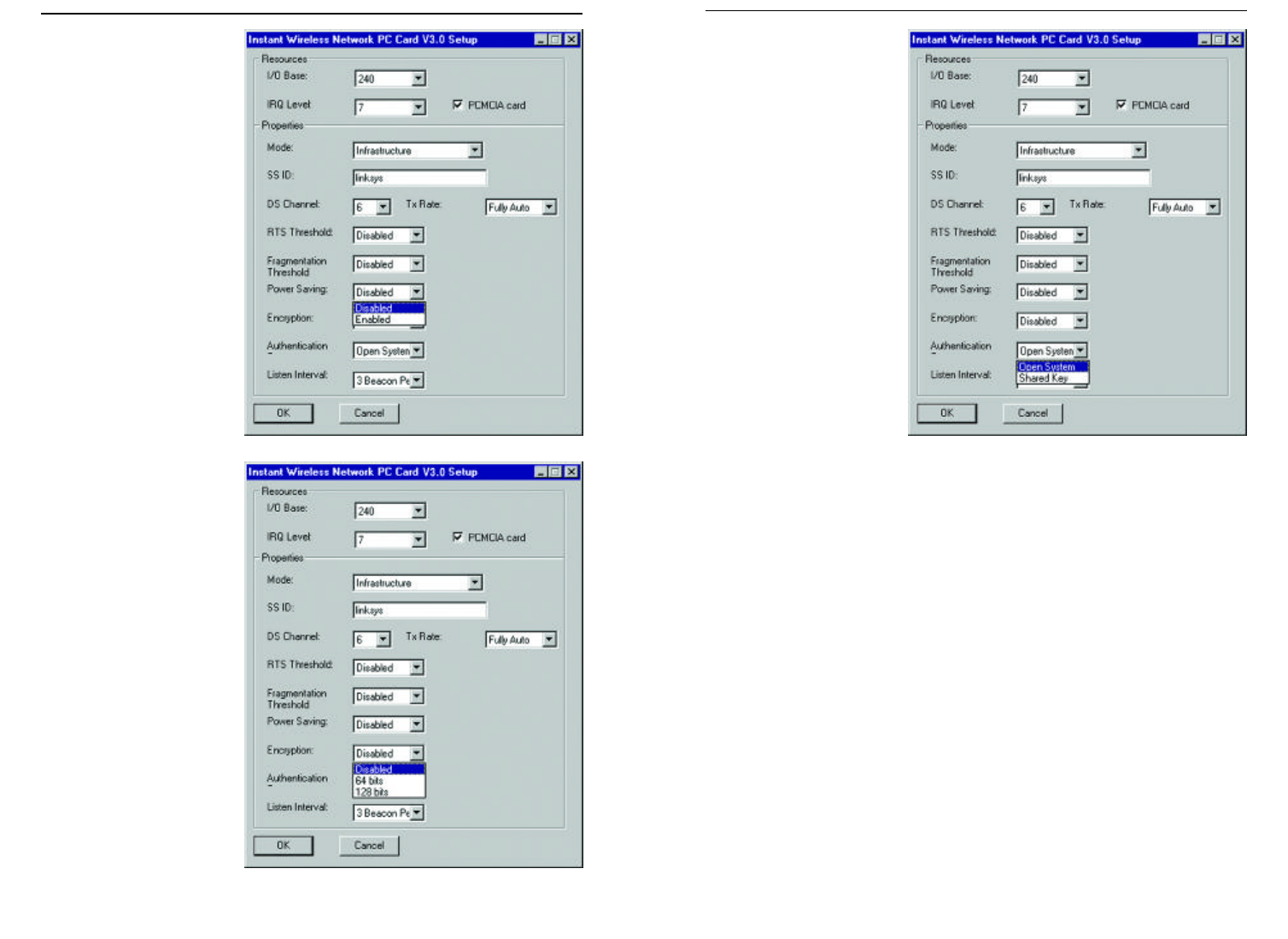
10. The Authentication
setting, shown in Figure
9-23, is Open System
by default. Open
System is another name
for WECA compliant.
WECA Compliant (Default) (also referred to as Open Authentication)
The sender and recipient do NOT share a secret key. Each party generates
its own key-pair and asks the receiver to accept the generated key. Once
accepted, this key is used for a short time only; thereafter a new key is gen-
erated and agreed upon.
Shared Key (Optional)
This is when both the sender and recipient share the same key. They use this
key for an extended length of time. Any eavesdropper that discovers the key
may decipher all packets until the key is changed. As indicated, you should
always use WECA Compliant (Always Use) unless you have some other rea-
son to do so.
Choose Listen Interval to continue or the OK button to finish setting the
Advanced Options
8. Under Power Saving
mode (Figure 9-21),
select either Enabled
or Disabled. Disabled
will allow for uninter-
rupted data communi-
cation. Selecting
Enabled allows your
notebook to enter
“sleep” mode and
could interrupt data
communication. For
further information
about Power Save
Mode, see Chapter 7:
Configuration Utility.
9. Select either Disabled,
64 bit, or 128 bit as
the value under
Encryption, as shown
in Figure 9-22). Wired
Equivalent Privacy
(WEP) is an encryp-
tion scheme used to
protect wireless data
communication. The
Disabled setting pre-
vents the sharing of
data with other com-
puters on a WEP net-
work. For data sharing
to be enabled, select
either 64 or 128 bit
encryption.
Network PC Card
Figure 9-21
Figure 9-22
Figure 9-23
Instant Wireless
TM
Series
53 54
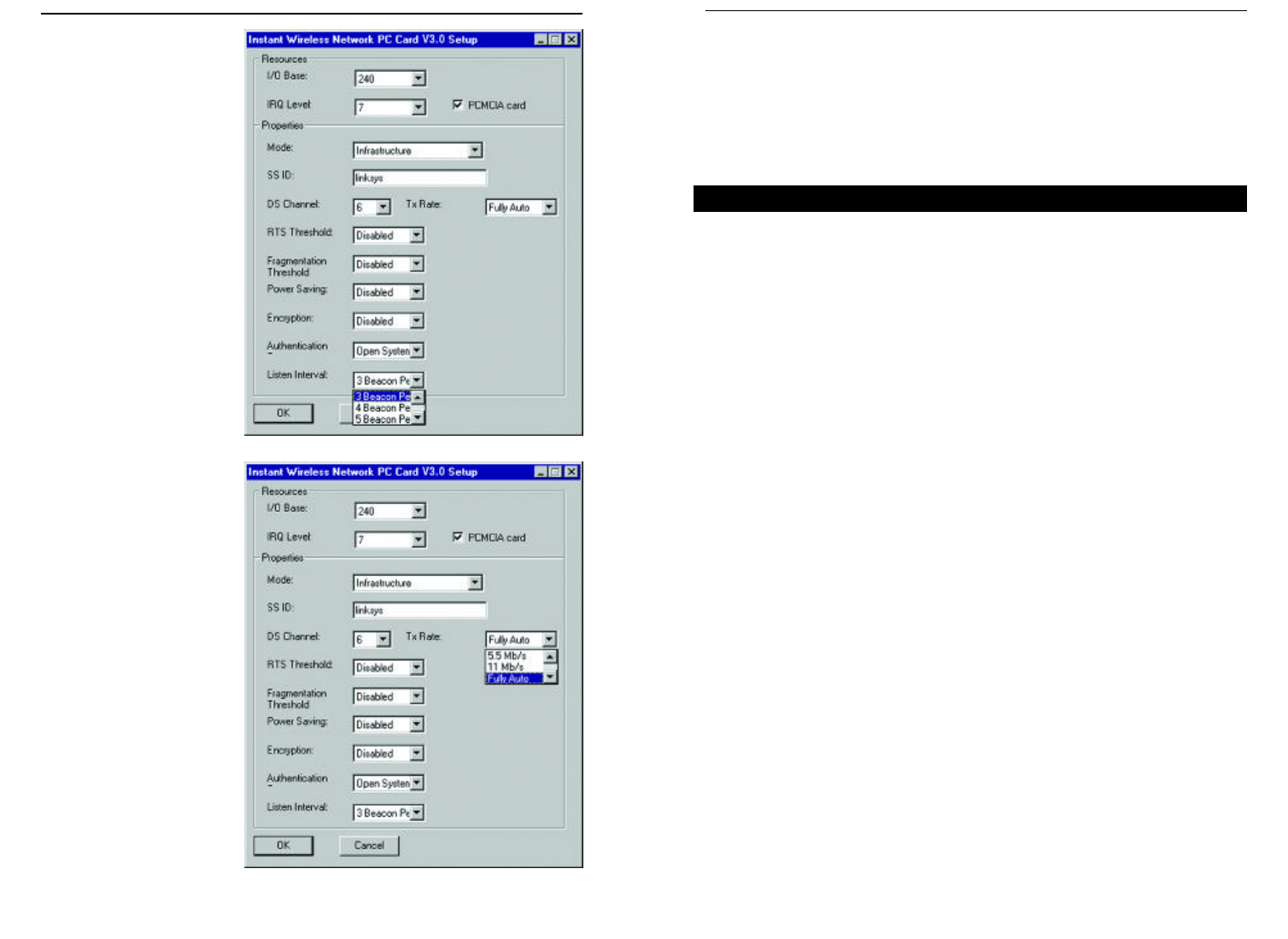
56
Chapter 10: Troubleshooting
This chapter provides solutions to problems usually occurring during the instal-
lation and operation of the Network PC Card. Read the description below to
solve your problems. If you can’t find an answer here, check the Linksys web-
site at www.linksys.com.
1.My computer does not recognize the Network PC Card.
Make sure that the Network PC Card is properly inserted into the PCMCIA
slot. Note that the card can be inserted either way, but only correctly when it
is inserted so that the “Instant Wireless” logo on the front of the card may not
be seen. If in doubt, try inserting the card both ways. The card will slide in
further when it is correct.
2.The Network PC Card does not work properly.
•Reinsert the Network PC Card into your notebook’s PCMCIA slot. A beep
should be heard if the card is properly inserted.
•For non-Windows environments, make sure that a PCMCIA card service
driver is installed on your PC.
•Open the Control Panel and click on the PC Card. Check whether it has a
PCMCIA card in one of the sockets or not. If you find the Network PC Card
in one of the sockets, it means the card has been detected properly. If you see
a yellow question mark, the resources are conflicting.
•Right-click on My Computer and select Properties. Select the device man-
ager and click the Network Adapter. You will find the Network PC Card if
it is installed successfully. If you see the yellow exclamation mark, the
resources are conflicting. Click PCMCIA card and then click PCMCIA
card service. You will see the status of the Network PC Card. If there is a
yellow question mark, please check the following:
•Make sure your notebook has a free IRQ.
•Make sure you have inserted the right card and installed the proper
driver.
Common Problems and Solutions
Network PC Card
11. The Listen Interval
setting, as shown in
Figure 9-24, should
remain at 1 Beacon per
Second. Setting this
higher could result in
slower data transfer.
12. The TX Rate setting, as
shown in Figure 9-25,
should remain Fully
Auto as set by default.
Changing this to a dif-
ferent transfer rate will
lock in that rate and
may result in dropped
connections.
Click the OK button to
complete setting these
options.
Figure 9-24
Figure 9-25
Instant Wireless
TM
Series
55

What is Infrastructure?
An integrated wireless and wired LAN is called an Infrastructure configura-
tion. Infrastructure is applicable to enterprise scale for wireless access to a cen-
tral database, or wireless application for mobile workers.
What is Roaming?
Roaming is the ability of a portable computer user to communicate continu-
ously while moving freely throughout an area greater than that covered by a sin-
gle Wireless Network Access Point.
To achieve true seamless connectivity, the wireless LAN must incorporate a
number of different functions. Each node and Wireless Network Access Point,
for example, must always acknowledge receipt of each message. Each node
must maintain contact with the wireless network even when not actually trans-
mitting data. Achieving these functions simultaneously requires a dynamic RF
networking technology that links Wireless Network Access Points and nodes.
In such a system, the user’s end node undertakes a search for the best possible
access to the system. First, it evaluates such factors as signal strength and qual-
ity, as well as the message load currently being carried by each Wireless
Network Access Point and the distance of each Wireless Network Access Point
to the wired backbone. Based on that information, the node next selects the
right Wireless Network Access Point and registers its address. Communications
between end node and host computer can then be transmitted up and down the
backbone.
As the user moves on, the end node’s RF transmitter regularly checks the sys-
tem to determine whether it is in touch with the original Wireless Network
Access Point or whether it should seek a new one. When a node no longer
receives acknowledgment from its original Wireless Network Access Point, it
undertakes a new search. Upon finding a new Wireless Network Access Point,
it then re-registers, and the communication process continues.
What is BSS ID?
A specific Ad-hoc LAN is called a Basic Service Set (BSS). Computers in a
BSS must be configured with the same BSS ID.
What is ESSID?
An Infrastructure configuration could also support roaming capability for
mobile workers. More than one BSS can be configured as an Extended Service
Set (ESS). Users within an ESS could roam freely between BSSs while main-
taining a continuous connection to the wireless network stations and Wireless
Network Access Points.
58
If the Network PC Card does not function after attempting the above steps,
remove the card and do the following:
•Uninstall the driver software from your PC.
•Restart your PC and repeat the hardware and software installation as
specified in this User Guide.
3.I cannot communicate with the other computers linked via Ethernet in
the Infrastructure configuration.
•Make sure that the notebook PC to which the Network PC Card is associat-
ed is powered on.
•Make sure that your Network PC Card is configured on the same channel and
with the same security options as the other computers in the Infrastructure
configuration.
Can I run an application from a remote computer over the wireless net-
work?
This will depend on whether or not the application is designed to be used over
a network. Consult the application’s documentation to determine if it supports
operation over a network.
Can I play multiplayer games with other users of the wireless network?
Yes, as long as the game supports multiple players over a LAN (local area net-
work). Refer to the game’s documentation for more information.
What is the IEEE 802.11b standard?
The IEEE 802.11b Wireless LAN standards subcommittee formulatings stan-
dards for the industry. The objective is to enable wireless LAN hardware from
different manufacturers to communicate.
What IEEE 802.11 features are supported?
The product supports the following IEEE 802.11 functions:
•CSMA/CA plus Acknowledge protocol
•Multi-Channel Roaming
•Automatic Rate Selection
•RTS/CTS feature
•Fragmentation
•Power Management
What is Ad-hoc?
An Ad-hoc wireless LAN is a group of computers, each with a Network PC
Card, connected as an independent wireless LAN. An Ad-hoc wireless LAN is
applicable at a departmental scale for a branch or SOHO operation.
57
Network PC Card
Frequently Asked Questions
Instant Wireless
TM
Series

60
What is ISM band?
The FCC and their counterparts outside of the U.S. have set aside bandwidth
for unlicensed use in the ISM (Industrial, Scientific and Medical) band.
Spectrum in the vicinity of 2.4 GHz, in particular, is being made available
worldwide. This presents a truly revolutionary opportunity to place convenient
high speed wireless capabilities in the hands of users around the globe.
What is Spread Spectrum?
Spread Spectrum technology is a wideband radio frequency technique devel-
oped by the military for use in reliable, secure, mission-critical communica-
tions systems. It is designed to trade off bandwidth efficiency for reliability,
integrity, and security. In other words, more bandwidth is consumed than in the
case of narrowband transmission, but the trade-off produces a signal that is, in
effect, louder and thus easier to detect, provided that the receiver knows the
parameters of the spread-spectrum signal being broadcast. If a receiver is not
tuned to the right frequency, a spread-spectrum signal looks like background
noise. There are two main alternatives, Direct Sequence Spread Spectrum
(DSSS) and Frequency Hopping Spread Spectrum (FHSS).
What is DSSS? What is FHSS? And what are their differences?
Frequency Hopping Spread Spectrum (FHSS) uses a narrowband carrier that
changes frequency in a pattern that is known to both transmitter and receiver.
Properly synchronized, the net effect is to maintain a single logical channel. To
an unintended receiver, FHSS appears to be short-duration impulse noise.
Direct Sequence Spread Spectrum (DSSS) generates a redundant bit pattern for
each bit to be transmitted. This bit pattern is called a chip (or chipping code).
The longer the chip, the greater the probability that the original data can be
recovered. Even if one or more bits in the chip are damaged during transmis-
sion, statistical techniques embedded in the radio can recover the original data
without the need for retransmission. To an unintended receiver, DSSS appears
as low power wideband noise and is rejected (ignored) by most narrowband
receivers.
Would the information be intercepted while transmitting on air?
WLAN features two-fold protection in security. On the hardware side, as with
Direct Sequence Spread Spectrum technology, it has the inherent security fea-
ture of scrambling. On the software side, the WLAN series offers the encryp-
tion function (WEP) to enhance security and access control. Users can set it up
depending upon their needs.
59
Can Instant WirelessTM products support file and printer sharing?
Instant WirelessTM products perform the same function as LAN products.
Therefore, Instant WirelessTM products can work with Netware, Windows
NT/2000, or other LAN operating systems to support printer or file sharing.
What is WEP?
WEP is Wired Equivalent Privacy, a data privacy mechanism based on a 40 bit
shared key algorithm, as described in the IEEE 802.11 standard.
Network PC Card
Instant Wireless
TM
Series

61
devices access the line at exactly the same time, their signals collide. When the
collision is detected, they both back off and each wait a random amount of time
before retrying.
Database - A database is a collection of data that is organized so that its contents
can easily be accessed, managed, and updated.
Default Gateway - The routing device used to forward all traffic that is not
addressed to a station within the local subnet.
DHCP (Dynamic Host Configuration Protocol) - A protocol that lets network
administrators manage centrally and automate the assignment of Internet
Protocol (IP) addresses in an organization's network. Using the Internet's set of
protocol (TCP/IP), each machine that can connect to the Internet needs a unique
IP address. When an organization sets up its computer users with a connection to
the Internet, an IP address must be assigned to each machine. Without DHCP, the
IP address must be entered manually at each computer and, if computers move to
another location in another part of the network, a new IP address must be entered.
DHCP lets a network administrator supervise and distribute IP addresses from a
central point and automatically sends a new IP address when a computer is
plugged into a different place in the network.
DHCP uses the concept of a "lease" or amount of time that a given IP address
will be valid for a computer. The lease time can vary depending on how long a
user is likely to require the Internet connection at a particular location. It's espe-
cially useful in education and other environments where users change frequently.
Using very short leases, DHCP can dynamically reconfigure networks in which
there are more computers than there are available IP addresses.
DHCP supports static addresses for computers containing Web servers that need
a permanent IP address.
Domain - A subnetwork comprised of a group of clients and servers under the
control of one security database. Dividing LANs into domains improves per-
formance and security.
Driver - A workstation or server software module that provides an interface
between a network interface card and the upper-layer protocol software running
in the computer; it is designed for a specific NIC, and is installed during the ini-
tial installation of a network-compatible client or server operating system.
Network PC Card
Chapter 11: Glossary
Ad-hoc Network - An ad-hoc network is a wireless network or other small net-
work in which some of the network devices are part of the network only for the
duration of a communications session while in some close proximity to the rest
of the network.
Architecture - The total design and implementation of the network. It includes
the network's topology, transmission technologies and communications proto-
cols, management and security systems, and any other attributes that give a net-
work a particular set of capabilities and functionalities.
Backbone - The part of a network that connects most of the systems and net-
works together and handles the most data.
Bandwidth - The transmission capacity of a given facility, in terms of how much
data the facility can transmit in a fixed amount of time; expressed in bits per sec-
ond (bps).
Bit - A binary digit. The value - 0 or 1-used in the binary numbering system.
Also, the smallest form of data.
BSS (Basic Service Set) - A group of Instant Wireless Network PC Card users
and an Access Point.
Buffer - A buffer is a shared or assigned memory area used by hardware devices
or program processes that operate at different speeds or with different sets of pri-
orities. The buffer allows each device or process to operate without being held up
by the other. In order for a buffer to be effective, the size of the buffer and the
algorithms for moving data into and out of the buffer need to be considered by
the buffer designer. Like a cache, a buffer is a "midpoint holding place" but exists
not so much to accelerate the speed of an activity as to support the coordination
of separate activities.
CSMA/CD (Carrier Sense Multiple Access/Collision Detection) - The LAN
access method used in Ethernet. When a device wants to gain access to the net-
work, it checks to see if the network is quiet (senses the carrier). If it is not, it
waits a random amount of time before retrying. If the network is quiet and two
Instant Wireless
TM
Series
62

63
Hop - The link between two network nodes.
IEEE (The Institute of Electrical and Electronics Engineers) - The IEEE
describes itself as "the world's largest technical professional society, promoting
the development and application of electrotechnology and allied sciences for the
benefit of humanity, the advancement of the profession, and the well-being of our
members."
The IEEE fosters the development of standards that often become national and
international standards. The organization publishes a number of journals, has
many local chapters, and several large societies in special areas, such as the IEEE
Computer Society.
Infrastructure - An infrastructure network is a wireless network or other small
network in which the wireless network devices are made a part of the network
through the Access Point which connects them to the rest of the network.
IP Address - In the most widely installed level of the Internet Protocol (Internet
Protocol) today, an IP address is a 32-binary digit number that identifies each
sender or receiver of information that is sent in packet across the Internet. When
you request an HTML page or send e-mail, the Internet Protocol part of TCP/IP
includes your IP address in the message (actually, in each of the packets if more
than one is required) and sends it to the IP address that is obtained by looking up
the domain name in the Uniform Resource Locator you requested or in the e-mail
address you're sending a note to. At the other end, the recipient can see the IP
address of the Web page requestor or the e-mail sender and can respond by send-
ing another message using the IP address it received.
IPX (Internetwork Packet EXchange) - A NetWare communications protocol
used to route messages from one node to another. IPX packets include network
addresses and can be routed from one network to another.
IRQ (Interrupt ReQuest) - A hardware interrupt on a PC. There are 16 IRQ lines
used to signal the CPU that a peripheral event has started or terminated. In most
cases, two devices cannot use the same line.
ISM band - The FCC and their counterparts outside of the U.S. have set aside
bandwidth for unlicensed use in the ISM (Industrial, Scientific and Medical)
band. Spectrum in the vicinity of 2.4 GHz, in particular, is being made available
worldwide. This presents a truly revolutionary opportunity to place convenient
high-speed wireless capabilities in the hands of users around the globe.
Network PC Card
DSSS (Direct-Sequence Spread-Spectrum) - DSSS generates a redundant bit pat-
tern for each bit to be transmitted. This bit pattern is called a chip (or chipping
code). The longer the chip, the greater the probability that the original data can
be recovered. Even if one or more bits in the chip are damaged during transmis-
sion, statistical techniques embedded in the radio can recover the original data
without -the need for retransmission. To an unintended receiver, DSSS appears as
low power wideband noise and is rejected (ignored) by most narrowband
receivers.
Encryption - A security method that applies a specific algorithm to data in order
to alter the data's appearance and prevent other devices from reading the infor-
mation.
ESS - More than one BSS in a network.
Ethernet - IEEE standard network protocol that specifies how data is placed on
and retrieved from a common transmission medium. Has a transfer rate of 10
Mbps. Forms the underlying transport vehicle used by several upper-level proto-
cols, including TCP/IP and XNS.
FHSS (Frequency Hopping Spread Spectrum) - FHSS continuously changes the
center frequency of a conventional carrier several times per second according to
a pseudo-random set of channels, while chirp spread spectrum changes the car-
rier frequency. Because a fixed frequency is not used, illegal monitoring of spread
spectrum signals is extremely difficult, if not downright impossible depending on
the particular method.
Firmware - Programming that is inserted into programmable read-only memory
(programmable read-only memory), thus becoming a permanent part of a com-
puting device.
Fragmentation - Breaking a packet into smaller units when transmitting over a
network medium that cannot support the original size of the packet.
Gateway - A device that interconnects networks with different, incompatible
communications protocols.
Hardware - Hardware is the physical aspect of computers, telecommunications,
and other information technology devices. The term arose as a way to distinguish
the "box" and the electronic circuitry and components of a computer from the
program you put in it to make it do things. The program came to be known as the
software.
64
Instant Wireless
Series

Packet - A unit of data routed between an origin and a destination in a network.
Passphrase - Used much like a password, a passphrase simplifies the WEP
encryption process by automatically generating the WEP encryption keys for
Linksys products.
PC Card - A credit-card sized removable module that contains memory, I/O, or
a hard disk.
PCMCIA - The PCMCIA (Personal Computer Memory Card International
Association) is an industry group organized in 1989 to promote standards for a
credit card-size memory or I/O device that would fit into a personal computer,
usually a notebook or laptop computer.
Plug-and-Play - The ability of a computer system to configure expansion boards
and other devices automatically without requiring the user to turn off the system
during installation.
Roaming - The ability to use a wireless device and be able to move from one
access point's range to another without losing the connection.
RTS (Request To Send) - An RS-232 signal sent from the transmitting station to
the receiving station requesting permission to transmit.
Server - Any computer whose function in a network is to provide user access to
files, printing, communications, and other services.
Software - Instructions for the computer. A series of instructions that performs a
particular task is called a "program." The two major categories of software are
"system software" and "application software." System software is made up of
control programs such as the operating system and database management system
(DBMS). Application software is any program that processes data for the user.
A common misconception is that software is data. It is not. Software tells the
hardware how to process the data.
Spread Spectrum - Spread Spectrum technology is a wideband radio frequency
technique developed by the military for use in reliable, secure, mission-critical
communications systems. It is designed to trade off bandwidth efficiency for reli-
ability, integrity, and security. In other words, more bandwidth is consumed than
in the case of narrowband transmission, but the trade off produces a signal that
is, in effect, louder and thus easier to detect, provided that the receiver knows the
66
Network PC Card
LAN - A local area network (LAN) is a group of computers and associated
devices that share a common communications line and typically share the
resources of a single processor or server within a small geographic area (for
example, within an office building).
Mbps (MegaBits Per Second) - One million bits per second; unit of measure-
ment for data transmission.
NetBEUI (NetBIOS Extended User Interface) - The transport layer for NetBIOS.
NetBIOS and NetBEUI were originally part of a single protocol suite that was
later separated. NetBIOS sessions can be transported over NetBEUI, TCP/IP and
SPX/IPX protocols.
NetBIOS - The native networking protocol in DOS and Windows networks.
Although originally combined with its transport layer protocol (NetBEUI),
NetBIOS today provides a programming interface for applications at the session
layer (layer 5). NetBIOS can ride over NetBEUI, its native transport, which is not
routable, or over TCP/IP and IPX/SPX, which are routable protocols.
NetBIOS computers are identified by a unique 15-character name, and Windows
machines (NetBIOS machines) periodically broadcast their names over the net-
work so that Network Neighborhood can catalog them. For TCP/IP networks,
NetBIOS names are turned into IP addresses via manual configuration in an
LMHOSTS file or a WINS server.
There are two NetBIOS modes. The Datagram mode is the fastest mode, but does
not guarantee delivery. It uses a self-contained packet with send and receive
name, usually limited to 512 bytes. If the recipient device is not listening for mes-
sages, the datagram is lost. The Session mode establishes a connection until bro-
ken. It guarantees delivery of messages up to 64KB long.
Network - A system that transmits any combination of voice, video and/or data
between users.
Node - A network junction or connection point, typically a computer or work sta-
tion.
Notebook (PC) - A notebook computer is a battery-powered personal computer
generally smaller than a briefcase that can easily be transported and convenient-
ly used in temporary spaces such as on airplanes, in libraries, temporary offices,
and at meetings. A notebook computer, sometimes called a laptop computer, typ-
ically weighs less than five pounds and is three inches or less in thickness.
Instant Wireless
TM
Series
65

Chapter 12: Specifications
Standards: IEEE 802.11b
Channels: 11 Channels (US, Canada)
13 Channels (Europe)
14 Channels (Japan)
Operating Range:
Indoors: Up to 30M (100 ft.) @ 11 Mbps
Up to 50M (165 ft.) @ 5.5 Mbps
Up to 70M (230 ft.) @ 2 Mbps
Up to 91M (300 ft.) @ 1 Mbps
Outdoors: Up to 152M (500 ft.) @ 11 Mbps
Up to 270M (885 ft.) @ 5.5 Mbps
Up to 396M (1300 ft.) @ 2 Mbps
Up to 457M (1500 ft.) @ 1 Mbps
Data Rate (Mbps): Up to 11Mbps (with automatic scale back)
LEDs: Link, Power
Dimensions: 4.5"x 2"x 0.3"(115mm x 54mm x 8mm)
Unit Weight: 1.65 oz. (47g)
Power: 3.3V or 5V DC, 275mA Tx, 225mA Rx,
200mA Standby
Certifications: FCC Class B, CE Mark Commercial
Operating Temp.: 32ºF to 131ºF (0ºC to 55ºC)
Storage Temp.: -4ºF to 158ºF (-20ºC to 70ºC)
Operating Humidity: 0% to 90% Non-Condensing
Storage Humidity: 0% to 95% Non-Condensing
68
Environmental
parameters of the spread-spectrum signal being broadcast. If a receiver is not
tuned to the right frequency, a spread-spectrum signal looks like background
noise. There are two main alternatives, Direct Sequence Spread Spectrum
(DSSS) and Frequency Hopping Spread Spectrum (FHSS).
Static IP Address - A permanent IP address that is assigned to a node in an IP
or a TCP/IP network.
TCP (Transmission Control Protocol) - A method (protocol) used along with the
Internet Protocol (Internet Protocol) to send data in the form of message units
between computers over the Internet. While IP takes care of handling the actual
delivery of the data, TCP takes care of keeping track of the individual units of
data (called packet) that a message is divided into for efficient routing through
the Internet.
TCP/IP (Transmission Control Protocol/Internet Protocol) - The basic commu-
nication language or protocol of the Internet. It can also be used as a communi-
cations protocol in a private network (either an intranet or an extranet). When you
are set up with direct access to the Internet, your computer is provided with a
copy of the TCP/IP program just as every other computer that you may send mes-
sages to or get information from also has a copy of TCP/IP.
Throughput - The amount of data moved successfully from one place to anoth-
er in a given time period.
Topology - A network's topology is a logical characterization of how the devices
on the network are connected and the distances between them. The most common
network devices include hubs, switches, routers, and gateways. Most large net-
works contain several levels of interconnection, the most important of which
include edge connections, backbone connections, and wide-area connections.
TX Rate - Transmission Rate.
WEP (Wired Equivalent Privacy) - A data privacy mechanism based on a 64-bit
or 128-bit shared key algorithm, as described in the IEEE 802.11 standard.
Workgroup - Two or more individuals that share files and databases.
67
Instant Wireless
Series
Network PC Card

Chatper 14: Contact Information
For help with the installation or operation of this product, contact Linksys
Technical Support at one of the phone numbers or Internet addresses below.
Sales Information 800-546-5797 (LINKSYS)
Technical Support 866-242-8558
RMA Issues 949-261-1288
Fax 949-261-8868
Email support@linksys.com
Web http://www.linksys.com
FTP Site ftp.linksys.com
70
Network PC Card
69
Chapter 13: Warranty Information
BE SURE TO HAVE YOUR PROOF OF PURCHASE AND A BARCODE
FROM THE PRODUCT’S PACKAGING ON HAND WHEN CALLING.
RETURN REQUESTS CANNOT BE PROCESSED WITHOUT PROOF OF
PURCHASE.
IN NO EVENT SHALL LINKSYS’S LIABILITY EXCEED THE PRICE
PAID FOR THE PRODUCT FROM DIRECT, INDIRECT, SPECIAL, INCI-
DENTAL, OR CONSEQUENTIAL DAMAGES RESULTING FROM THE
USE OF THE PRODUCT, ITS ACCOMPANYING SOFTWARE, OR ITS
DOCUMENTATION. LINKSYS DOES NOT OFFER REFUNDS FOR ANY
PRODUCT.
LINKSYS OFFERS CROSS SHIPMENTS, A FASTER PROCESS FOR PRO-
CESSING AND RECEIVING YOUR REPLACEMENT. LINKSYS PAYS
FOR UPS GROUND ONLY. ALL CUSTOMERS LOCATED OUTSIDE OF
THE UNITED STATES OF AMERICA AND CANADA SHALL BE HELD
RESPONSIBLE FOR SHIPPING AND HANDLING CHARGES. PLEASE
CALL LINKSYS FOR MORE DETAILS.
Instant Wireless
Series
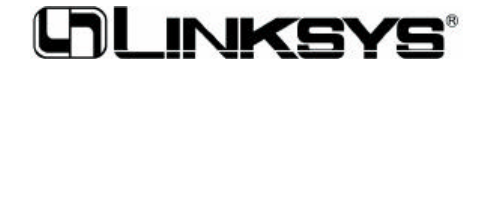
© Copyright 2002 Linksys, All Rights Reserved.
http://www.linksys.com